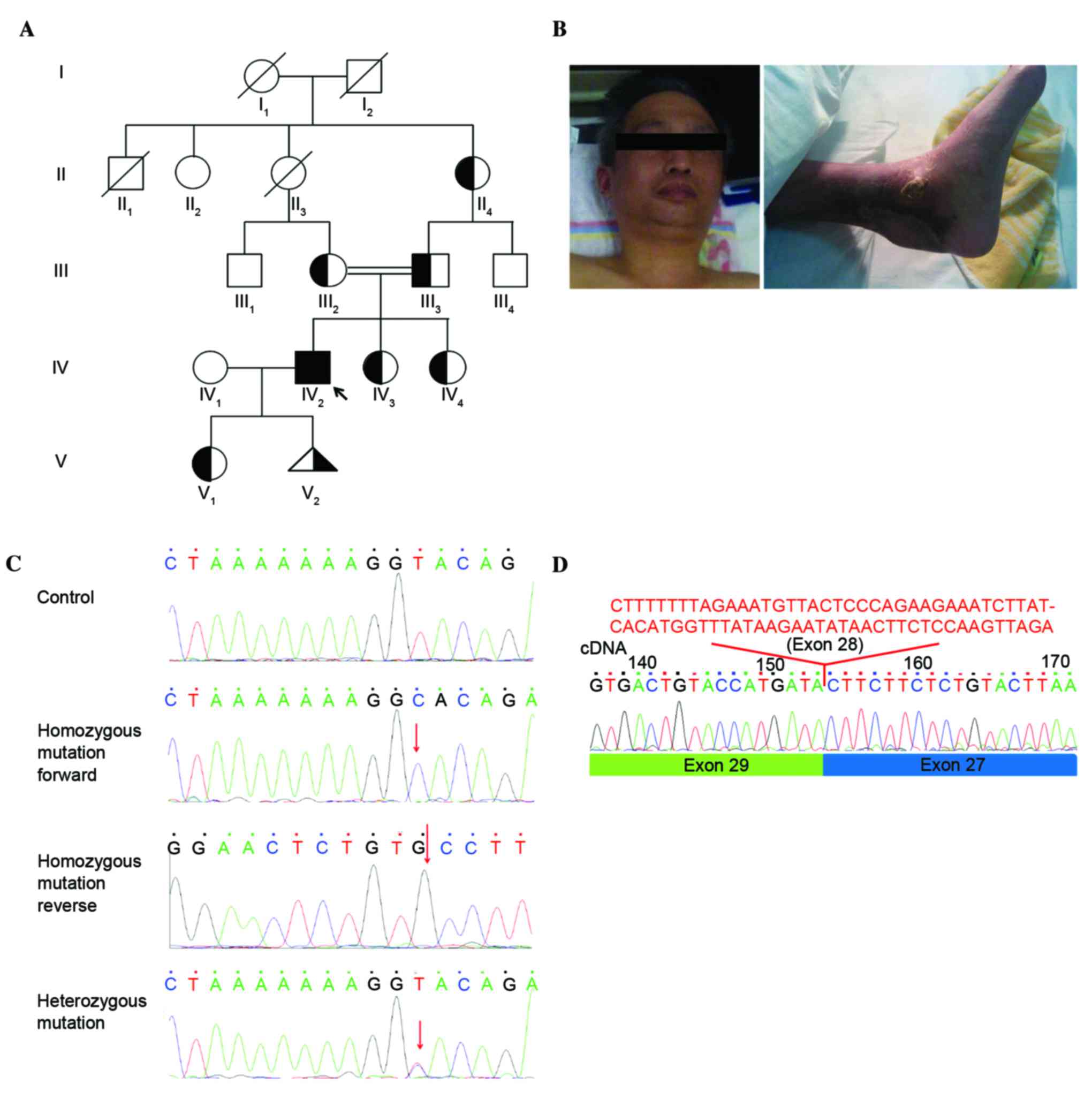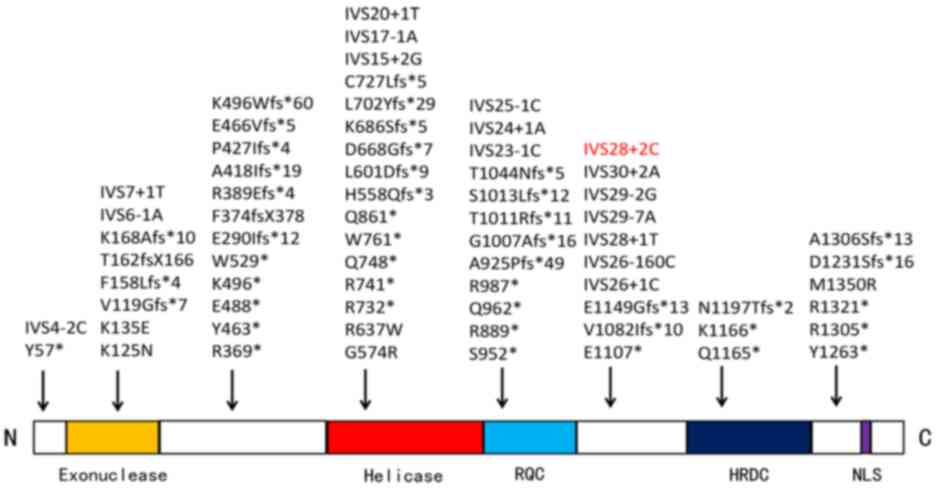|
1
|
Masala MV, Scapaticci S, Olivieri C,
Pirodda C, Montesu MA, Cuccuru MA, Pruneddu S, Danesino C and
Cerimele D: Epidemiology and clinical aspects of Werner's syndrome
in North Sardinia: Description of a cluster. Eur J Dermatol.
17:213–216. 2007.PubMed/NCBI
|
|
2
|
Hasty P, Campisi J, Hoeijmakers J, van
Steeg H and Vijg J: Aging and genome maintenance: Lessons from the
mouse? Science. 299:1355–1359. 2003. View Article : Google Scholar : PubMed/NCBI
|
|
3
|
Chen L, Lee L, Kudlow BA, Dos Santos HG,
Sletvold O, Shafeghati Y, Botha EG, Garg A, Hanson NB, Martin GM,
et al: LMNA mutations in atypical Werner's syndrome. Lancet.
362:440–445. 2003. View Article : Google Scholar : PubMed/NCBI
|
|
4
|
Muftuoglu M, Oshima J, von Kobbe C, Cheng
WH, Leistritz DF and Bohr VA: The clinical characteristics of
Werner syndrome: Molecular and biochemical diagnosis. Hum Genet.
124:369–377. 2008. View Article : Google Scholar : PubMed/NCBI
|
|
5
|
Oshima J and Hisama FM: Search and
insights into novel genetic alterations leading to classical and
atypical Werner syndrome. Gerontology. 60:239–246. 2014. View Article : Google Scholar : PubMed/NCBI
|
|
6
|
Friedrich K, Lee L, Leistritz DF, Nürnberg
G, Saha B, Hisama FM, Eyman DK, Lessel D, Nürnberg P, Li C, et al:
WRN mutations in Werner syndrome patients: Genomic rearrangements,
unusual intronic mutations and ethnic-specific alterations. Hum
Genet. 128:103–111. 2010. View Article : Google Scholar : PubMed/NCBI
|
|
7
|
Yu CE, Oshima J, Fu YH, Wijsman EM, Hisama
F, Alisch R, Matthews S, Nakura J, Miki T, Ouais S, et al:
Positional cloning of the Werner's syndrome gene. Science.
272:258–262. 1996. View Article : Google Scholar : PubMed/NCBI
|
|
8
|
Sinha JK, Ghosh S and Raghunath M:
Progeria: A rare genetic premature ageing disorder. Indian J Med
Res. 139:667–674. 2014.PubMed/NCBI
|
|
9
|
Choudhary S, Sommers JA and Brosh RM Jr:
Biochemical and kinetic characterization of the DNA helicase and
exonuclease activities of werner syndrome protein. J Biol Chem.
279:34603–34613. 2004. View Article : Google Scholar : PubMed/NCBI
|
|
10
|
Orren DK, Theodore S and Machwe A: The
Werner syndrome helicase/exonuclease (WRN) disrupts and degrades
D-loops in vitro. Biochemistry. 41:13483–13488. 2002. View Article : Google Scholar : PubMed/NCBI
|
|
11
|
Zhang W, Li J, Suzuki K, Qu J, Wang P,
Zhou J, Liu X, Ren R, Xu X, Ocampo A, et al: Aging stem cells. A
Werner syndrome stem cell model unveils heterochromatin alterations
as a driver of human aging. Science. 348:1160–1163. 2015.
View Article : Google Scholar : PubMed/NCBI
|
|
12
|
Laud PR, Multani AS, Bailey SM, Wu L, Ma
J, Kingsley C, Lebel M, Pathak S, De Pindo RA and Chang S: Elevated
telomere-telomere recombination in WRN-deficient, telomere
dysfunctional cells promotes escape from senescence and engagement
of the ALT pathway. Gen Dev. 19:2560–2570. 2005. View Article : Google Scholar
|
|
13
|
Eller MS, Liao X, Liu S, Hanna K, Bäckvall
H, Opresko PL, Bohr VA and Gilchrest BA: A role for WRN in
telomere-based DNA damage responses. Proc Natl Acad Sci USA.
103:pp. 15073–15078. 2006; View Article : Google Scholar : PubMed/NCBI
|
|
14
|
Dhillon KK, Sidorova J, Saintigny Y, Poot
M, Gollahon K, Rabinovitch PS and Monnat RJ Jr: Functional role of
the Werner syndrome RecQ helicase in human fibroblasts. Aging Cell.
6:53–61. 2007. View Article : Google Scholar : PubMed/NCBI
|
|
15
|
Kudlow BA, Kennedy BK and Monnat RJ Jr:
Werner and Hutchinson-Gilford progeria syndromes: Mechanistic basis
of human progeroid diseases. Nat Rev Mol Cell Biol. 8:394–404.
2007. View
Article : Google Scholar : PubMed/NCBI
|
|
16
|
Monnat RJ Jr and Saintigny Y: Werner
syndrome protein-unwinding function to explain disease. Sci Aging
Knowledge Environ. 2004:re32004. View Article : Google Scholar : PubMed/NCBI
|
|
17
|
Kipling D, Davis T, Ostler EL and Faragher
RG: What can progeroid syndromes tell us about human aging?
Science. 305:1426–1431. 2004. View Article : Google Scholar : PubMed/NCBI
|
|
18
|
Csoka AB, Cao H, Sammak PJ, Constantinescu
D, Schatten GP and Hegele RA: Novel lamin A/C gene (LMNA) mutations
in atypical progeroid syndromes. J Med Genet. 41:304–308. 2004.
View Article : Google Scholar : PubMed/NCBI
|
|
19
|
Renard D, Fourcade G, Milhaud D, Bessis D,
Esteves-Vieira V, Boyer A, Roll P, Bourgeois P, Levy N and De
Sandre-Giovannoli A: Novel LMNA mutation in atypical Werner
syndrome presenting with ischemic disease. Stroke. 40:e11–e14.
2009. View Article : Google Scholar : PubMed/NCBI
|
|
20
|
Lessel D, Hisama FM, Szakszon K, Saha B,
Sanjuanelo AB, Salbert BA, Steele PD, Baldwin J, Brown WT, Piussan
C, et al: POLD1 germline mutations in patients initially diagnosed
with Werner syndrome. Human mutation. 36:1070–1079. 2015.
View Article : Google Scholar : PubMed/NCBI
|
|
21
|
Barcena C, Osorio FG and Freije JM:
Detection of nuclear envelope alterations in senescence. Methods
Mol Biol. 965:243–251. 2013. View Article : Google Scholar : PubMed/NCBI
|
|
22
|
Tan ZP, Huang C, Xu ZB, Yang JF and Yang
YF: Novel ZFPM2/FOG2 variants in patients with double outlet right
ventricle. Clin Genet. 82:466–471. 2012. View Article : Google Scholar : PubMed/NCBI
|
|
23
|
Xiang R, Fan LL, Huang H, Cao BB, Li XP,
Peng DQ and Xia K: A novel mutation of GATA4 (K319E) is responsible
for familial atrial septal defect and pulmonary valve stenosis.
Gene. Oct 26–2013.(Epub ahead of print).
|
|
24
|
Edgar RC: MUSCLE: Multiple sequence
alignment with high accuracy and high throughput. Nucleic Acids
Res. 32:1792–1797. 2004. View Article : Google Scholar : PubMed/NCBI
|
|
25
|
Kadari A, Mekala S, Wagner N, Malan D,
Köth J, Doll K, Stappert L, Eckert D, Peitz M, Matthes J, et al:
Robust generation of cardiomyocytes from human iPS cells requires
precise modulation of BMP and WNT signaling. Stem Cell Rev.
11:560–569. 2015. View Article : Google Scholar : PubMed/NCBI
|
|
26
|
Gotoh A, Hamada Y, Shiobara N, Kumagai K,
Seto K, Horikawa T and Suzuki R: Skew in T cell receptor usage with
polyclonal expansion in lesions of oral lichen planus without
hepatitis C virus infection. Clin Exp Immunol. 154:192–201. 2008.
View Article : Google Scholar : PubMed/NCBI
|
|
27
|
Oshitari T, Kitahashi M, Mizuno S, Baba T,
Kubota-Taniai M, Takemoto M, Yokote K, Yamamoto S and Roy S: Werner
syndrome with refractory cystoid macular edema and
immunohistochemical analysis of WRN proteins in human retinas. BMC
Ophthalmol. 14:312014. View Article : Google Scholar : PubMed/NCBI
|
|
28
|
Prince PR, Emond MJ and Monnat RJ Jr: Loss
of Werner syndrome protein function promotes aberrant mitotic
recombination. Genes Dev. 15:933–938. 2001. View Article : Google Scholar : PubMed/NCBI
|
|
29
|
Saintigny Y, Makienko K, Swanson C, Emond
MJ and Monnat RJ Jr: Homologous recombination resolution defect in
werner syndrome. Mol Cell Biol. 22:6971–6978. 2002. View Article : Google Scholar : PubMed/NCBI
|
|
30
|
Chang S, Multani AS, Cabrera NG, Naylor
ML, Laud P, Lombard D, Pathak S, Guarente L and DePinho RA:
Essential role of limiting telomeres in the pathogenesis of Werner
syndrome. Nat Genet. 36:877–882. 2004. View
Article : Google Scholar : PubMed/NCBI
|
|
31
|
Crabbe L, Verdun RE, Haggblom CI and
Karlseder J: Defective telomere lagging strand synthesis in cells
lacking WRN helicase activity. Science. 306:1951–1953. 2004.
View Article : Google Scholar : PubMed/NCBI
|
|
32
|
Jones B: Ageing: Heterochromatin
disorganization associated with premature ageing. Nat Rev Genet.
16:3182015. View
Article : Google Scholar : PubMed/NCBI
|
|
33
|
Floch AG, Tareste D, Fuchs PF, Chadrin A,
Naciri I, Léger T, Schlenstedt G, Palancade B and Doye V: Nuclear
pore targeting of the yeast Pom33 nucleoporin depends on
karyopherin and lipid binding. J Cell Sci. 128:305–316. 2015.
View Article : Google Scholar : PubMed/NCBI
|
|
34
|
Oshima J, Yu CE, Piussan C, Klein G,
Jabkowski J, Balci S, Miki T, Nakura J, Ogihara T, Ells J, et al:
Homozygous and compound heterozygous mutations at the Werner
syndrome locus. Hum Mol Genet. 5:1909–1913. 1996. View Article : Google Scholar : PubMed/NCBI
|











